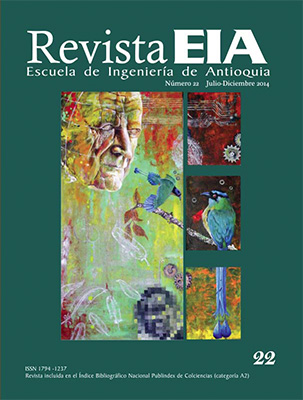CARACTERIZACIÓN Y MODELACIÓN DEL COMPORTAMIENTO HIDRÁULICO DE UN REACTOR UASB
CARACTERIZACIÓN Y MODELACIÓN DEL COMPORTAMIENTO HIDRÁULICO DE UN REACTOR UASB


This work is licensed under a Creative Commons Attribution-NonCommercial-NoDerivatives 4.0 International License.
Copyright statement
The authors exclusively assign to the Universidad EIA, with the power to assign to third parties, all the exploitation rights that derive from the works that are accepted for publication in the Revista EIA, as well as in any product derived from it and, in in particular, those of reproduction, distribution, public communication (including interactive making available) and transformation (including adaptation, modification and, where appropriate, translation), for all types of exploitation (by way of example and not limitation : in paper, electronic, online, computer or audiovisual format, as well as in any other format, even for promotional or advertising purposes and / or for the production of derivative products), for a worldwide territorial scope and for the entire duration of the rights provided for in the current published text of the Intellectual Property Law. This assignment will be made by the authors without the right to any type of remuneration or compensation.
Consequently, the author may not publish or disseminate the works that are selected for publication in the Revista EIA, neither totally nor partially, nor authorize their publication to third parties, without the prior express authorization, requested and granted in writing, from the Univeridad EIA.
Show authors biography
RESUMEN
La tasa de conversión de la materia orgánica en un biorreactor depende principalmente de dos factores: la actividad biológica y la hidráulica del reactor (Peña-Varón, Mara y Avella-Rodríguez, 2006). Por lo anterior, es necesario conocer el comportamiento hidráulico de los sistemas de tratamiento usando sustancias trazadoras a fin de determinar el comportamiento del flujo: pistón, mezcla completa, dispersión; existencia de zonas muertas, corto-circuitos, flujos advectivos y el tiempo de retención hidráulico real. El objetivo de este artículo es modelar el comportamiento hidráulico de un sistema UASB-Upflow Anaerobic Sludge Blanket (en español RAFA-reactor anaerobio de flujo ascendente), por medio de una prueba de trazadores utilizando Rodamina WT a través de la técnica estímulo-respuesta, los modelos para flujo no ideal que se utilizaron son modelo de tanques en serie y modelo de dispersión. Con ello se determinó que el sistema UASB en estudio tiene un comportamiento de un reactor completamente mezclado con presencia de cortocircuitos y zonas muertas.
ABSTRACT
The conversion rate of organic matter in a bioreactor depends on two main factors: the reactor’s biological and hydraulic activity (Peña-Varón, Mara & Avella-Rodríguez, 2006). It is therefore necessary to understand treatment systems’ hydraulic behavior by using tracer substances in order to determine flow behavior: piston, complete mix, dispersion; the existence of dead zones, short circuits, advective flows, and real hydraulic retention time. The goal of this article is to model the hydraulic behavior of a UASB (Upflow Anaerobic Sludge Blanket) system through a tracer test using rhodamine WT and the stimulus-response technique. The non-ideal flow models used were the tanks in series model and the dispersion model. We thereby determined that the UASB system being studied showed the behavior of a completely mixed reactor with short circuits and dead zones.
Article visits 352 | PDF visits 249
